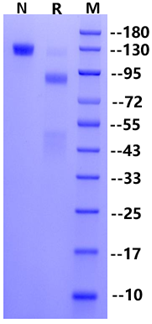80-90kDa
Reconstitute at 0.1-1 mg/ml according to the size in ultrapure water after rapid centrifugation.
1、Garcia S. et al. (2007) c-Met overexpression in inflammatory breast carcinomas: automated quantification on tissue microarrays. British journal of cancer. 96(2): 329-335.
2、Socoteanu M P. et al. (2008) c-Met targeted therapy of cholangiocarcinoma. World J Gastroenterol. 14(19): 2990-2994.
3、Kong D S. et al. (2009) Prognostic significance of c-Met expression in glioblastomas. Cancer. 115(1): 140-8.
4、McGill GG, et al. (2006) c-Met expression is regulated by Mitf in the melanocyte lineage. J Biol Chem. 281(15): 10365-73.
HGF R, also known as Met, is a glycosylated receptor tyrosine kinase that plays a central role in epithelial morphogenesis and cancer development. HGF R is synthesized as a single chain precursor which undergoes cotranslational proteolytic cleavage. This generates a mature HGFR that is a disulfide-linked dimer composed of a 50 kDa extracellular alpha chain and a 145 kDa transmembrane beta chain.. The extracellular domain (ECD) contains a seven bladed beta-propeller sema domain, a cysteine-rich PSI/MRS, and four Ig-like E-set domains, while the cytoplasmic region includes the tyrosine kinase domain. HGFR is normally expressed by cells of epithelial origin, while expression of HGF is restricted to cells of mesenchymal origin.


Immobilized HGFR/c-MET His Tag Protein, Human (Cat. No. UA010226) at 2.0μg/mL (100μL/well) can bind Anti-Human MET (Emibetuzumab) with EC50 of 2.00-3.30ng/mL.